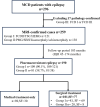The response to anti-seizure medications and the development of pharmacoresistant epilepsy in malformations of cortical development
- PMID: 40189511
- PMCID: PMC11974206
- DOI: 10.1186/s12916-025-04019-9
The response to anti-seizure medications and the development of pharmacoresistant epilepsy in malformations of cortical development
Abstract
Background: Malformations of cortical development (MCD) are a group of congenital brain malformation disorders commonly associated with pharmacoresistant epilepsy (PRE). While studies often focus on surgery outcomes, the pharmacological treatment is still imperative and the odyssey to PRE remains underexplored. We aim to investigate the influence of anti-seizure medications (ASMs) on the development of PRE in this specific patient population.
Methods: We retrospectively included a cohort of epilepsy patients with MRI-confirmed MCD due to abnormal cell proliferation and apoptosis (group I, mainly FCD II), and abnormal neuronal migration (group II, mainly heterotopia, lissencephaly, and polymicrogyria) from March 2013 to June 2023. The clinical features of group I and group II were compared. Factors associated with PRE were analyzed. The time to development of PRE with different ASMs was assessed using Kaplan-Meier survival analysis.
Results: Of 259 enrolled patients with epilepsy and MRI-confirmed MCD (group I, n = 121; group II, n = 138), 73.4% met the criteria for PRE. The median duration of follow-up from seizure onset to the last visit or surgery was 103 months (IQR 45-174), with group I showing a significantly higher PRE rate than group II (90.1% vs. 58.7%, p = 0.000). Binomial regression analysis identified the significant predictors of PRE in MCD patients: high pretreatment seizure frequency (OR = 2.506), group II patients (OR = 0.248), and failure of the first ASM (OR = 5.885). Sodium channel blockers (SCBs) were the most prescribed initial ASMs and demonstrated a higher response rate than other ASMs. Kaplan-Meier analysis revealed that using SCBs as the first ASM significantly prolongs the time to PRE, with a median of 72 months for SCB users versus 48 months for non-SCB users.
Conclusions: Our findings indicate a high prevalence of PRE that varies among different subtypes of MCD. Early appropriate selection of ASMs, particularly SCBs, can significantly delay the time to PRE onset, offering a promising strategy for managing this complex patient population. Tailoring pharmacological approaches is crucial for optimizing outcomes, and further research is warranted to optimize treatment strategies.
Keywords: Malformations of cortical development; Pharmacoresistant epilepsy; Sodium channel blockers.
© 2025. The Author(s).
Conflict of interest statement
Declarations. Ethics approval and consent to participate: This study was approved by the Medical Ethics Committee of the Second Affiliated Hospital, Zhejiang University School of Medicine (2022–0336). Consent for publication: Not applicable. Competing interests: The authors declare no competing interests.
Figures




References
-
- Raybaud C, Widjaja E. Development and dysgenesis of the cerebral cortex: malformations of cortical development. Neuroimaging Clin N Am. 2011;21(3):483–543, vii. - PubMed
-
- Zvi IB, Enright N, D’Arco F, Tahir MZ, Chari A, Cross JH, Eltze C, Tisdall MM. Children with seizures and radiological diagnosis of focal cortical dysplasia: can drug-resistant epilepsy be predicted earlier? Epileptic Disord. 2022;24(1):111–22. - PubMed
-
- Licchetta L, Vignatelli L, Toni F, Teglia A, Belotti LMB, Ferri L, Menghi V, Mostacci B, Di Vito L, Bisulli F, Tinuper P. Long-term Outcome of Epilepsy and Cortical Malformations Due to Abnormal Migration and Postmigrational Development. Neurology. 2022;99(1):e23–32. - PubMed
MeSH terms
Substances
LinkOut - more resources
Full Text Sources
Miscellaneous

